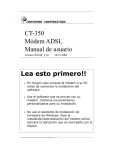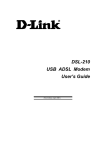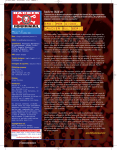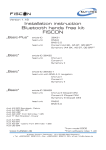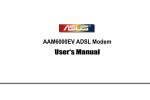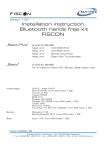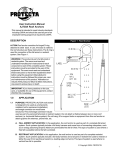Download Asus AAM6000UG User guide
Transcript
ASUS AAM6000UG USB ADSL Modem User Guide Version 2.1 For Software Version 9.5 THE SPECIFICATIONS AND INFORMATION REGARDING THE PRODUCTS IN THIS MANUAL ARE SUBJECT TO CHANGE WITHOUT NOTICE. ALL STATEMENTS, INFORMATION, AND RECOMMENDATIONS IN THIS MANUAL ARE BELIEVED TO BE ACCURATE BUT ARE PRESENTED WITHOUT WARRANTY OF ANY KIND, EXPRESS OR IMPLIED. USERS MUST TAKE FULL RESPONSIBILITY FOR THEIR APPLICATION OF ANY PRODUCTS. THE SOFTWARE LICENSE AND LIMITED WARRANTY FOR THE ACCOMPANYING PRODUCT ARE SET FORTH IN THE INFORMATION PACKET THAT SHIPPED WITH THE PRODUCT AND ARE INCORPORATED HEREIN BY THIS REFERENCE. NOTWITHSTANDING ANY OTHER WARRANTY HEREIN, ALL DOCUMENT FILES AND SOFTWARE OF THESE SUPPLIERS ARE PROVIDED “AS IS” WITH ALL FAULTS. PRODUCT AND THE ABOVE-NAMED SUPPLIERS DISCLAIM ALL WARRANTIES, EXPRESSED OR IMPLIED, INCLUDING, WITHOUT LIMITATION, THOSE OF MERCHANTABILITY, FITNESS FOR A PARTICULAR PURPOSE AND NONINFRINGEMENT OR ARISING FROM A COURSE OF DEALING, USAGE, OR TRADE PRACTICE. IN NO EVENT SHALL PRODUCT OR ITS SUPPLIERS BE LIABLE FOR ANY INDIRECT, SPECIAL, CONSEQUENTIAL, OR INCIDENTAL DAMAGES, INCLUDING, WITHOUT LIMITATION, LOST PROFITS OR LOSS OR DAMAGE TO DATA ARISING OUT OF THE USE OR INABILITY TO USE THIS MANUAL, EVEN IF PRODUCT OR ITS SUPPLIERS HAVE BEEN ADVISED OF THE POSSIBILITY OF SUCH DAMAGES. ASUS and the ASUS logo are registered trademarks of ASUSTek COMPUTER INC. All other trademarks mentioned in this document are the property of their respective owners. The use of the word partner does not imply a partnership relationship between ASUS and any of its resellers. ASUS AAM6000UG A1 User Guide Text Part Number: 6000-0001 ASUSTek COMPUTER INC. No. 15, Li-Te Rd., Peitou, Taipei, Taiwan, R.O.C. www.asus.com COPYRIGHT ©2002 THE MANUFATURER. All Rights Reserved. Contents 1 Preface............................................................................................................1 Purpose....................................................................................................................................................... 1 Organization................................................................................................................................................ 1 Conventions ................................................................................................................................................ 1 2 Introduction....................................................................................................3 Overview ..................................................................................................................................................... 3 Features ...................................................................................................................................................... 3 System Requirements................................................................................................................................. 3 3 Hardware Installation ....................................................................................5 Hardware Overview..................................................................................................................................... 5 Parts List ........................................................................................................................................ 5 USB Connectors ............................................................................................................................ 6 Splitter and Microfilter.................................................................................................................................. 6 Front Panel LEDs........................................................................................................................................ 7 4 Modem Setup and Driver Installation ..........................................................9 Prepare to Install the DSLMON Software and USB Driver ......................................................................... 9 MPoA Bridge or Routed Setting ................................................................................................................ 10 Setting Up USB Network IP Address ........................................................................................... 12 PPPoA or PPPoE Setting.......................................................................................................................... 15 Internet Access PPP Setting ........................................................................................................ 17 Connection Status Monitoring ................................................................................................................... 18 5 Advanced Control Menu .............................................................................19 General Configuration ............................................................................................................................... 19 Viewing General Statistic .......................................................................................................................... 20 ATM and DSL Status .................................................................................................................... 20 Advanced of AAL Link Status ....................................................................................................... 21 Advanced Debugging................................................................................................................................ 21 6 Remove and Upgrade..................................................................................23 Remove versus Upgrade the Modem Driver ............................................................................................ 23 Remove Procedure ................................................................................................................................... 23 Upgrade Procedure................................................................................................................................... 24 Rollback Procedure................................................................................................................................... 26 Appendix A .......................................................................................................27 ADSL-Related Acronyms .......................................................................................................................... 27 This page is leave in blank for note or memo use 1 Preface This preface guide you how the document is organized, the purpose of this document and it conventions. It includes the following topic: z Purpose z Organization z Conventions Purpose The purpose of this guide is to provide detailed information and description about how to configure the AAM6000UG USB ADSL Modem and contains comprehensive configuration examples. Organization This guide contains the following information: y y y y y y Preface Introduction Hardware Installation Modem Setup and Driver Installation Advanced Control Menu Remove and Upgrade Conventions This section describes the conventions used in this guide. 9 – Indicate the attention or any notices caution relay on the topical subjects. This page is leave in blank for note or memo use 2 ADSL Modem User’s Manual 2 Introduction This chapter provides a general overview of AAM6000UG USB Modem. It covers the key features and main applications of your Modem. z Overview z Feature z System Requirements Overview Thanks you for purchasing this ADSL Modem. This ADSL Modem delivers the highest performance in Asymmetric Digital Subscriber Line technology, allowing you to simultaneously enjoy telephone and Internet service using existing copper phone lines. Ideal for home and small business users, this existing copper phone lines, Ideal for home and small business users, this easy-to-use ADSL Modem offers reliable connectivity and remarkable data transfer rates. Once the ADSL Modem is online, you can enjoy real-time 3D animation, video conferencing, or perform other data intensive operations. Features Software Feature y Supports RFC 2346 protocol (PPP over ATM), RFC 2516 (PPP over Ethernet), RFC 1483 encapsulation (multiple protocol over ATM AAL5), and TFC 1577 protocol (classical IP over ATM) y Software upgrade y User Maintenance System Requirements The AAM6000UG ADSL Modem requires that your computer has a USB (Universal Series Bus) 1.1 or 2.0 compatible port. 9 You must have your USB port free and capable to use before connect to AAM6000UG ADSL Modem, USB Hub or other extend USB device are not recommend to connect with AAM6000UG ADSL Modem. Operating System Support y Windows 98SE y Windows ME y Windows 2000 y Windows XP y Windows 2003 Server 3 This page is leave in blank for note or memo use 4 ADSL Modem User’s Manual 3 Hardware Installation This chapter introduces the ports and LED indicators. z Hardware Overview z USB Connectors z Splitter Installation z Front Panel LEDs Hardware Overview Have your system operating disk or CD handy during the installation, in case a specific file can not be found on your computer due to installation. USB Cable Connect to PC RJ-11 Phone Cable connect to Wall or Splitter The back panel has two interfaces: y USB – Connecting to PC USB port y LINE – Connecting RJ-11 Phone cable to Phone Jack or Splitter Parts List AAM6000UG USB Modem ADSL Modem User’s Manual Splitter RJ-11 Phone Cable 5 USB Cable Quick Installation Guide (Optional) Installation CD USB Connectors See the following figure for an explanation of USB connectors. This cable end will plug into your Modem’s USB port This cable end will plug into your computer’s USB port Splitter Installation Use a Splitter in order to plug a phone into the same telephone line. y y y 6 Modem port – connect to USB Modem Phone port – connect to Phone Set Line port – connect to telephone wall jack or out line ADSL Modem User’s Manual Front Panel LEDs Power WAN DATA LED Color Status Description POWER Yellow On USB is connected and receives power. Off Modem’s USB port is not connected or not receiving power. On DSL link is up. Blinking DSL in Handshaking training status. Off No DSL connection. Blinking Data transfer over DSL line. WAN DATA Yellow Yellow ADSL Modem User’s Manual 7 This page is leave in blank for note or memo use 8 ADSL Modem User’s Manual 4 Modem Setup and Driver Installation This chapter shows you how to set up your Modem for ADSL Internet access. z Prepare to Install the DSLMON Software and USB Driver z MPoA Bridge or Routed Setting z PPPoA or PPPoE Setting z Connection Status Monitoring Prepare to Install the DSLMON Software and USB Driver Before install the AAM6000UG USB ADSL Modem, you should have information below from your Internet Service Provide (ISP) or Telephone Company. Once the information has confirmed, you may now choose one of the installation type, “MPoA Bridge/Routed” or “PPPoA/PPPoE”, follow by the sections below to complete driver installation. MPoA Bridge/Routed Needed Information Required Information Default Value VPI: The Virtual Path Identifier number identifies a bundle of virtual channels. 8 VCI: The Virtual Path Identifier number identifies a logical connection between end stations. 35 Framing Type & Encapsulation: Bridge LLC/VC MUX or Route LLC/VC MUX Bridge LLC Connection Standard: ANSI T1.413, G.lite, G.dmt, Multi-Standard Multi-Standard IP address: (When using Static IP) The IP address given from your ISP. Automatically Subnet Mask: (When using Static IP) The subnet Mask given from your ISP. Automatically Default Gateway: (When using Static IP) The default gateway given from your ISP. Automatically Preferred DNS Server: (When using Static IP) Primary DNS server IP given from your ISP. Automatically Alternate DNS Server: (When using Static IP) Secondary DNS server IP given from your ISP. Automatically ADSL Modem User’s Manual Fill in the Blanks 9 PPPoA/PPPoE Needed Information Required Information Default Value VPI: The Virtual Path Identifier number identifies a bundle of virtual channels. 8 VCI: The Virtual Path Identifier number identifies a logical connection between end stations. 35 Framing Type & Encapsulation: Bridge LLC/VC MUX or Route LLC/VC MUX Bridge LLC Connection Standard: ANSI T1.413, G.lite, G.dmt, Multi-Standard Multi-Standard User Name and Password: Let your ISP know which account you are loggin into and protects your account from unauthorized users. N/A Fill in the Blanks MPoA Bridge or Routed Setting 9 10 DO NOT connect the modem to your computer at this time. Step 1 Close all Windows programs and applications. Step 2 Insert the CD that came with your Modem into your computer. It should automatically run the driver setup program. If the setup is not automatically run, you can open the CD on your computer and double click the Setup.exe icon Step 3 When the following window appears, click OK. ADSL Modem User’s Manual Step 4 When “Eagle II USB ADSL Modem Setup window” appears, click Next. Step 5 Next, select the “MPoA Bridge/Routed” as driver type and click Next. ADSL Modem User’s Manual 11 Step 6 Screens pop up to report the progress of the installation. You do not need to click anything until installation complete, selected “Yes, I want to restart my computer now”, and click Finish to have your computer restart. Step 7 After system restarted, you can now connect USB Modem to your PC, several screens pop up to inform USB driver installation progress, when the following window appear, click OK. Setting Up USB Network IP Address This section is relevant when you select MPoA Bridge/Routed driver type using a given IP address on. 9 Please have your AAM6000UG USB ADSL Modem connecting to PC. Follow the steps to set up your USB computer to use a static IP address given by your ISP. Window XP screen shots are shown. Steps and screen shots may very depend on the version of Windows. Step 1 Click Start Æ Control Panel Æ Network and Internet Connection Æ Network Connections. Step 2 Double click on the Network Connection icon to open the window screen. 9 12 The follow screen may very from this user guide depending on your MS Windows version. ADSL Modem User’s Manual Step 3 Right-click on the icon that corresponds to your new USB connection “USB ADSL LAN Adapter” (not the one that corresponds to your Ethernet NIC) and select Properties. Step 4 In the Properties screen, make sure the Connect Using field displays “USB ADSL LAN Adapter”. Step 5 Select Internet Protocol (TCP/IP) and click Properties. Step 6 Click Use the following IP address and fill in the IP address (given by your ISP), Subnet mask, and Default gateway fields; as same as DNS server address (given by your ISP). ADSL Modem User’s Manual 13 5 Advanced Control Menu This chapter shows you how to view advanced modem information. z General Configuration z Viewing General Statistics z Advanced Debugging General Configuration Step 1 Double click on the DSLMON icon. Step 2 Press the ALT and D keys simultaneously to bring up the following window. This is CONFIG tab for the ATM VPI/VCI and encapsulation setting. ADSL Modem User’s Manual 19 The following table describes the labels in this CONFIG window. LABEL Description ATM Channel These are the Virtual Path and Virtual Channel identifiers. Encapsulation Type This shows the mode of encapsulation chosen during Modem installation. ADSL Standard ADSL connection modulation type used to establish physical communications with the DSL provider. Viewing General Statistic ATM and DSL Status Click the ATM/DSL tab to view ATM-related statistics as seen in this window. These statistics refer to data collected on the active virtual channels. The following table describes the labels in this window. 20 LABEL Description DSL This is the information of ADSL physical status. ATM This is the information of ATM cell layer status. Packet This is the information of Ethernet layer packet status. ADSL Modem User’s Manual Advanced of AAL Link Status Click Advanced tab to view AAL (ATM Adapt Layer) related statistics as seen in this window. The following table describes the labels in this window. LABEL Description Packet Statistics This is the total number of AAL 5 layer packet statistics. OAM This is the total number of ATM OAM cell statistics. ATM Statistics This is the total number of ATM cell statistics. DSL Frame Counts This is the total number of ADSL Frame counters. Margin This is upstream and downstream margin values. Advanced Debugging CMV, TEST, and Graph tabs are for engineering debugging only, you may not needs to viewing or configuring in advice. ADSL Modem User’s Manual 21 This page is leave in blank for note or memo use 22 ADSL Modem User’s Manual 6 Remove and Upgrade This chapter tells how to uninstall and reinstall your Modem’s software driver. z Remove versus Upgrade the Modem Driver z Remove Procedure z Upgrade Procedure z Rollback Procedure Remove versus Upgrade the Modem Driver Remove the Modem driver if you are no longer to using the AAM6000UG USB Modem, Upgrade and Rollback the Modem driver if you are having trouble with current version. Remove Procedure Follow these steps to completely remove your Modem’s software driver. Step 1 Close all windows programs and application. Step 2 Make sure the Installation CD is in your computer, Double click the Setup.exe icon as you did when you first set up the Modem. The “Eagle II USB ADSL Modem Setup” window appears. Select Remove all install components and click Next. Step 3 Click OK to confirm the remove process. ADSL Modem User’s Manual 23 5 Advanced Control Menu This chapter shows you how to view advanced modem information. z General Configuration z Viewing General Statistics z Advanced Debugging General Configuration Step 1 Double click on the DSLMON icon. Step 2 Press the ALT and D keys simultaneously to bring up the following window. This is CONFIG tab for the ATM VPI/VCI and encapsulation setting. ADSL Modem User’s Manual 19 The following table describes the labels in this CONFIG window. LABEL Description ATM Channel These are the Virtual Path and Virtual Channel identifiers. Encapsulation Type This shows the mode of encapsulation chosen during Modem installation. ADSL Standard ADSL connection modulation type used to establish physical communications with the DSL provider. Viewing General Statistic ATM and DSL Status Click the ATM/DSL tab to view ATM-related statistics as seen in this window. These statistics refer to data collected on the active virtual channels. The following table describes the labels in this window. 20 LABEL Description DSL This is the information of ADSL physical status. ATM This is the information of ATM cell layer status. Packet This is the information of Ethernet layer packet status. ADSL Modem User’s Manual Advanced of AAL Link Status Click Advanced tab to view AAL (ATM Adapt Layer) related statistics as seen in this window. The following table describes the labels in this window. LABEL Description Packet Statistics This is the total number of AAL 5 layer packet statistics. OAM This is the total number of ATM OAM cell statistics. ATM Statistics This is the total number of ATM cell statistics. DSL Frame Counts This is the total number of ADSL Frame counters. Margin This is upstream and downstream margin values. Advanced Debugging CMV, TEST, and Graph tabs are for engineering debugging only, you may not needs to viewing or configuring in advice. ADSL Modem User’s Manual 21 This page is leave in blank for note or memo use 22 ADSL Modem User’s Manual 6 Remove and Upgrade This chapter tells how to uninstall and reinstall your Modem’s software driver. z Remove versus Upgrade the Modem Driver z Remove Procedure z Upgrade Procedure z Rollback Procedure Remove versus Upgrade the Modem Driver Remove the Modem driver if you are no longer to using the AAM6000UG USB Modem, Upgrade and Rollback the Modem driver if you are having trouble with current version. Remove Procedure Follow these steps to completely remove your Modem’s software driver. Step 1 Close all windows programs and application. Step 2 Make sure the Installation CD is in your computer, Double click the Setup.exe icon as you did when you first set up the Modem. The “Eagle II USB ADSL Modem Setup” window appears. Select Remove all install components and click Next. Step 3 Click OK to confirm the remove process. ADSL Modem User’s Manual 23 Step 4 You may needs to restart your computer to accomplish the remove process, select “Yes, I want to restart my Computer now”, and click Finish. Upgrade Procedure Follow these steps to completely upgrade your Modem’s software driver. 24 Step 1 Close all windows programs and application. Step 2 Make sure the Installation CD is in your computer, Double click the Setup.exe icon as you did when you first set up the Modem. The “Eagle II USB ADSL Modem Setup” window appears. Select Upgrade to the new driver and click Next. ADSL Modem User’s Manual Step 3 Select the “PPPoA/PPPoE” as driver type and click Next. Step 4 You may needs to restart your computer to accomplish the remove process, select “Yes, I want to restart my Computer now”, and click Finish. ADSL Modem User’s Manual 25 Rollback Procedure Follow these steps to completely Rollback to old driver of your Modem’s software driver. 26 Step 1 Close all windows programs and application. Step 2 Make sure the Installation CD is in your computer, Double click the Setup.exe icon as you did when you first set up the Modem. The “Eagle II USB ADSL Modem Setup” window appears. Select Rollback to the old driver and click Next. Step 3 You may needs to restart your computer to accomplish the remove process, select “Yes, I want to restart my Computer now”, and click Finish. ADSL Modem User’s Manual Appendix A ADSL-Related Acronyms ADSL Asymmetric High bit rate Digital Subscriber Line ANSI American National Standards Institute ARP Address Resolution Protocol ATM Asynchronous Transfer Protocol BootP Bootstrap Protocol CHAP Challenge-Handshake Authentication Protocol DHCP Dynamic Host Configuration Protocol DMT Discrete Multi-Tone DSLAM Digital Subscriber Line Access Multiplexer IETF RFC Internet Engineering Task Force Request for Comments IPCP Internet Protocol Control Protocol IPoA IP over ATM ITU International Telecommunication Union ITU-T ITU Telecommunication Standardization Sector MAC (address) Media Access Control (address) MPoA Multi Protocol Encapsulation over ATM Adaptation Layer 5 NAT Network Address Translation PAP Password Authentication Protocol POTS Plain Old Telephone Service POP Point-to-Point Protocol PPPoA PPP over ATM Adaptation Layer 5 PPPoE PPP over Ethernet PSTN Public Switched Telephone Network PVC Permanent Virtual Connection Telco Telephone Company TCP/IP Transmission Control Protocol / Internet Protocol TFTP Trivial File Transfer Protocol VCI Virtual Circuit Identifier VPI Virtual Path Identifier WAN Wide Area Network END OF DOCUMENT ADSL Modem User’s Manual 27































